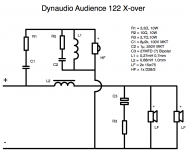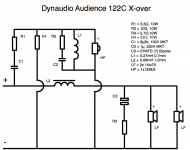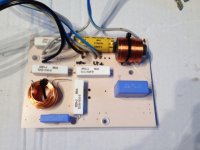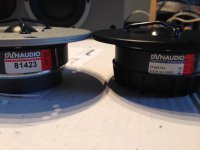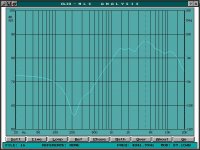This topic is old. But let me revive it, since I ran into a problem. As mentioned above, some three years ago I upgraded the cross-over network of my pair of Audience 122's with higher grade components, keeping the topology of the network intact. The result was very satisfying. Since then I've replaced those speakers with Dynauidio Special Twenty Five's, which I really adore. I've kept the Audience 122C centre speaker, since upgrading that to Contour or Confidence level is too big of an expense. So, I proceeded to upgrade the A122C.
The cross-over diagrams of both the A122 and A122C are provided. The inductor values of the A122 cross-over were kindly provided by Dynaudio. All parts in the A122C x-over are identical (except R4), as are system impedance, sensitivity and cross-over frequency. I therefore assumed the inductor values were also identical.
They are almost identical, except for R4, which is a 22R resistor which, I think, serves as a pad for the tweeter. The d28 in the A122C has an extra magnet for magnetic shielding, which also provides a little more output compared to it's brother.
I also came across an unused D260-DA tweeter, which I purchased with the intention of putting it in the A122C. I've rebuild the A122C cross-over with high quality parts, omitted the 22R, since the D260DA has (as far as I can tell) about the same output as the normal d28/2.
Now, having rebuild the speaker, I do have good frequency band seperation, but the tweeter is at least 3 - 5dB too loud from about 5k and up. How is this possible? Is the d260DA really that different in output (both level and energy distribution) than the D28/2?
I went to a renowned DIY-audio store in The Netherlands (Speakerland, Oss), which has quite a bit of know how on this subject. They helped me select components. They also agreed that it was fairly safe to assume the coil values were identical to those in the original A122. The ferrite core coil was subsituted for an air-core part with the same inductance. I can't imagine this is responsible for such a different sounding tweeter, since the cross-over frequency is at 2kHz.
Can anyone shed some light on this? Should I put back the old tweeter first, to determine if the problem is in the tweeter, or can anyone of you guys tell me straight away what the problem is, given the provided information?
I hope you can help.
Thanks!
James.
The cross-over diagrams of both the A122 and A122C are provided. The inductor values of the A122 cross-over were kindly provided by Dynaudio. All parts in the A122C x-over are identical (except R4), as are system impedance, sensitivity and cross-over frequency. I therefore assumed the inductor values were also identical.
They are almost identical, except for R4, which is a 22R resistor which, I think, serves as a pad for the tweeter. The d28 in the A122C has an extra magnet for magnetic shielding, which also provides a little more output compared to it's brother.
I also came across an unused D260-DA tweeter, which I purchased with the intention of putting it in the A122C. I've rebuild the A122C cross-over with high quality parts, omitted the 22R, since the D260DA has (as far as I can tell) about the same output as the normal d28/2.
Now, having rebuild the speaker, I do have good frequency band seperation, but the tweeter is at least 3 - 5dB too loud from about 5k and up. How is this possible? Is the d260DA really that different in output (both level and energy distribution) than the D28/2?
I went to a renowned DIY-audio store in The Netherlands (Speakerland, Oss), which has quite a bit of know how on this subject. They helped me select components. They also agreed that it was fairly safe to assume the coil values were identical to those in the original A122. The ferrite core coil was subsituted for an air-core part with the same inductance. I can't imagine this is responsible for such a different sounding tweeter, since the cross-over frequency is at 2kHz.
Can anyone shed some light on this? Should I put back the old tweeter first, to determine if the problem is in the tweeter, or can anyone of you guys tell me straight away what the problem is, given the provided information?
I hope you can help.
Thanks!
James.
Attachments
Hi there,
I've got a D28/2 and one version of a D260. By the measurements,
they are not interchangable without some filter modifications.
I know manufacturer's data look different, but I happen to
be "lucky" and own an odd one. The graph shows a D260 response
about a half of a meter from the speaker baffle. D28/2 I have does
not behave like this around 4kHz. Don't remember the voltage level.
I've got a D28/2 and one version of a D260. By the measurements,
they are not interchangable without some filter modifications.
I know manufacturer's data look different, but I happen to
be "lucky" and own an odd one. The graph shows a D260 response
about a half of a meter from the speaker baffle. D28/2 I have does
not behave like this around 4kHz. Don't remember the voltage level.
Attachments
Hi and Thanks.
I was afraid of something like that. I know someone over at AVSForum had an Audience 72 and was able (according to Michael from Dynaudio USA) to simply replace the d28 with the d260. But that was not a -DA version. He was happy with the results.
The guys at Speakerland didn't mention that a different impedance correction would be necessary. I *think* that what I hear is also sibilance at or around 4k, but can't tell exactly with my crude measurents. Can you elaborate on how incorrect impedance correction translates to sound quality? And what, if any, is or are the consequences for the amp driving that speaker?
I'll reconnect R4 and see what happens, level wise. It won't tame the sibilance, though. I'll also swap tweeters and compare.
Difficult to do without a proper work place and measurement gear.
I was afraid of something like that. I know someone over at AVSForum had an Audience 72 and was able (according to Michael from Dynaudio USA) to simply replace the d28 with the d260. But that was not a -DA version. He was happy with the results.
The guys at Speakerland didn't mention that a different impedance correction would be necessary. I *think* that what I hear is also sibilance at or around 4k, but can't tell exactly with my crude measurents. Can you elaborate on how incorrect impedance correction translates to sound quality? And what, if any, is or are the consequences for the amp driving that speaker?
I'll reconnect R4 and see what happens, level wise. It won't tame the sibilance, though. I'll also swap tweeters and compare.
Difficult to do without a proper work place and measurement gear.
Can you elaborate on how incorrect impedance correction translates to sound quality?
And what, if any, is or are the consequences for the amp driving that speaker?
At very high frequencies impedance correction(RC network) usually tilts
the response somewhat down in spl. The 4 kHz FR hill can't be
flattened with an RC, only RLC makes sense. You change all the parts
values so the impedance isn't unreasonably low and the response looks
the way you want it, if possible. Best to measure and load to a simulator.
- Status
- This old topic is closed. If you want to reopen this topic, contact a moderator using the "Report Post" button.
